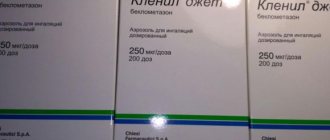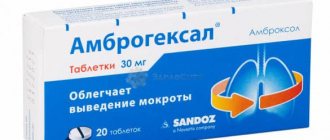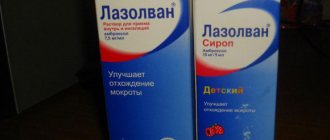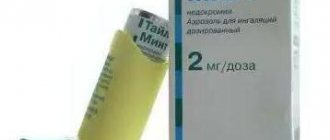Composition, release form
Clenil UDV for inhalation is produced in the form of a white, opalescent suspension, in which the active substance is distributed in the form of tiny particles. The main component, beclomethasone dipropionate, in its pure form is a white (or creamy) odorless powder.
1 ampoule contains the following components (their quantities are indicated in parentheses):
- beclomethasone dipropionate (800 mcg) is the main substance belonging to the group of steroids with high biological activity;
- sodium chloride (18 mg) – solvent (saline solution);
- polysorbate 20 (2 mg) and sorbitan laurate (0.4 mg) – emulsifiers, disperse system stabilizers;
- purified water (up to 2 ml) is a solvent.
The primary packaging is plastic ampoules (2 ml each), which are placed in aluminum strips of 5 pieces, which, in turn, are placed in cardboard boxes. The medicine is produced by the Italian pharmaceutical company CHIESI FARMACEUTICI, S. p. A, which specializes in the production of respiratory drugs.
The main active component is the first glucocorticosteroid, which is used for inhalation through a nebulizer. It was created more than 40 years ago, in 1972, and has been well studied in therapeutic practice. This drug is included in the WHO List of Essential Medicines.
Clenil UDV for inhalation
Glucocorticosteroids, used in inhaled form, currently belong to the basic therapy of bronchial asthma. The dosage of beclomethasone corresponds to the recommendations of GINA (the international organization Global Initiative for Bronchial Asthma) for children.
Mechanism of action
Clenil UDV for inhalation has the following pharmacokinetics and pharmacodynamics features:
- Upon penetration into the bronchi in the form of a fine aerosol, the active compound is deposited on the surface of the mucosa.
- Beclomethasone molecules enter small blood vessels and then into the systemic circulation. Since this substance has a low degree of hydrophobicity, it requires only 6 minutes to penetrate the mucosal barrier. 87% of the active component binds to blood proteins.
- After the procedure, part of the medication remains in the oral cavity and enters the gastrointestinal tract, but is deactivated in the liver and excreted in the feces in the form of inactive metabolites.
- Under the influence of enzymes, dipropionate is converted into monopropionate, which has a pronounced anti-inflammatory effect.
- Part of the active component forms ester compounds with fatty acids in the cells of the pulmonary epithelium, which do not have hormonal activity. This process is reversible, that is, esters are able to be reduced to the original substance. They can remain in the lungs for a long period, which causes a longer action and reduces the number of required doses to 1 per day. This process also reduces the entry of the drug into the systemic circulation.
Mechanism of action of inhaled glucocorticosteroids - In the lungs, the release of inflammatory mediators decreases.
- The production of lipomodulin increases, which blocks phospholipase A2. This disrupts the release of arachidonic acid, which is converted into prostaglandins. The latter compounds take an active part in the inflammatory process.
- The marginal accumulation of neutrophils and the release of inflammatory exudate are reduced.
- The intensity of migration of macrophages, immune cells that absorb foreign agents, decreases, which also helps slow down infiltration.
- The production of mucus by the bronchial glands decreases.
- The number of β-adrenergic receptors increases, their sensitivity is normalized, thereby restoring the patient’s sensitivity to bronchodilators - drugs to reduce spasms and symptoms of suffocation. This allows you to reduce the frequency of their use.
- The smooth muscles of the bronchi relax, their hyperreactivity to various stimuli decreases, in response to which bronchospasm develops.
- External respiration functions improve.
- The half-life of the active compound is 2-3 hours.
The advantage of this medicine is that it does not have a systemic effect and does not affect mineral metabolism, unlike oral forms of similar drugs. The effect of the active component also persists for some time after the end of treatment.
However, a pronounced therapeutic effect is achieved only after 5-7 days from the start of use. The active substance is also not able to relieve bronchospasm. For a course of treatment, the inhaled form of the drug can serve as a complete alternative to systemic glucocorticosteroids.
Subjectively, the therapeutic effect is manifested in the following:
- reduction in the number of exacerbations;
- easier breathing;
- greater control over symptoms;
- improving quality of life;
- milder course of exacerbations;
- reducing the risk of cardiovascular complications (myocardial infarction, stroke) as a result of reducing the severity of systemic inflammation.
Studies show that short-term courses lasting 1 week in children with frequent bronchial obstruction reduce the incidence of respiratory symptoms, which reduces the likelihood of developing bronchial asthma.
Clenil (aerial 250mcg/dose 200doses (with jet system))
Active substance
Beclomethasone
Compound
Balloon of 200 doses of Beclomethasone dipropionate 250 mcg per 1 dose. Excipients: glycerol, norflurane (1,1,1,2-tetrafluoroethane), ethanol.
pharmachologic effect
GKS. Has anti-inflammatory and anti-allergic effects. Inhibits the release of inflammatory mediators, increases the production of lipomodulin - an inhibitor of phospholipase A, reduces the release of arachidonic acid, and inhibits the synthesis of prostaglandins. Prevents the marginal accumulation of neutrophils, reducing the formation of inflammatory exudate and the production of lymphokines, inhibits the migration of macrophages, which leads to a slowdown in the processes of infiltration and granulation. Increases the number of active β-adrenergic receptors, neutralizes their desensitization, restores the patient's response to bronchodilators, allowing to reduce the frequency of their use. Under the influence of beclomethasone, the number of mast cells in the bronchial mucosa decreases, the swelling of the epithelium and the secretion of mucus by the bronchial glands decreases. Causes relaxation of bronchial smooth muscles, reduces their hyperreactivity and improves external respiration function. Does not have mineralocorticoid activity. In therapeutic doses it does not cause side effects characteristic of systemic corticosteroids. When used intranasally, it eliminates swelling and hyperemia of the nasal mucosa. The therapeutic effect usually develops after 5-7 days of course use of beclomethasone. When applied externally and locally, it has antiallergic and anti-inflammatory effects.
Indications for use
For inhalation use: treatment of bronchial asthma (including those with insufficient effectiveness of bronchodilators and/or sodium cromoglycate, as well as severe hormone-dependent bronchial asthma in adults and children). For intranasal use: prevention and treatment of year-round and seasonal allergic rhinitis, including hay fever rhinitis, vasomotor rhinitis. For external and local use: in combination with antimicrobial agents - infectious and inflammatory diseases of the skin and ear.
Mode of application
When administered by inhalation, the average dose for adults is 400 mcg/day, the frequency of use is 2-4 times/day. If necessary, the dose can be increased to 1 g/day. For children, a single dose is 50-100 mcg, frequency of use is 2-4 times a day. When administered intranasally, the dose is 400 mcg/day, the frequency of use is 1-4 times/day. For external and local use, the dose depends on the indications and the dosage form of the drug used.
Interaction
With simultaneous use of beclomethasone with other corticosteroids for systemic or intranasal use, increased suppression of adrenal cortex function is possible. Previous inhaled use of beta-agonists may increase the clinical effectiveness of beclomethasone.
Side effect
From the respiratory system: - hoarseness, feeling of irritation in the throat, sneezing; - rarely - cough; - in isolated cases - eosinophilic pneumonia, paradoxical bronchospasm, with intranasal use - perforation of the nasal septum. Candidiasis of the oral cavity and upper respiratory tract is possible, especially with long-term use, which resolves with local antifungal therapy without stopping treatment. Allergic reactions: rash, urticaria, itching, erythema and swelling of the eyes, face, lips and larynx. Effects caused by systemic action: decreased function of the adrenal cortex, osteoporosis, cataracts, glaucoma, growth retardation in children.
Contraindications
For inhalation and intranasal use: severe attacks of bronchial asthma requiring intensive care, tuberculosis, candidomycosis of the upper respiratory tract, first trimester of pregnancy, hypersensitivity to beclomethasone.
Use during pregnancy and breastfeeding Contraindicated in the first trimester of pregnancy. Use in the second and third trimesters of pregnancy is possible only when the expected benefit to the mother outweighs the potential risk to the fetus. Infants whose mothers received beclomethasone during pregnancy should be closely monitored for adrenal insufficiency. If it is necessary to use it during lactation, the issue of stopping breastfeeding should be decided.
Use in children Preparations for inhalation containing 250 mcg of beclomethasone in 1 dose are not intended for children under 12 years of age. For inhalation administration for children, a single dose is 50-100 mcg, frequency of use is 2-4 times a day.
special instructions
Beclomethasone is not intended for the relief of acute asthmatic attacks. It should also not be used for severe asthma attacks requiring intensive care. The recommended route of administration for the dosage form used should be strictly followed. Beclomethasone should be used with extreme caution and under close medical supervision in patients with adrenal insufficiency. The transfer of patients who constantly take GCS orally to inhaled forms can be done only if their condition is stable. If there is a possibility of developing paradoxical bronchospasm, bronchodilators (for example, salbutamol) are inhaled 10-15 minutes before the administration of beclomethasone. With the development of candidiasis of the oral cavity and upper respiratory tract, local antifungal therapy is indicated without stopping treatment with beclomethasone. Infectious and inflammatory diseases of the nasal cavity and paranasal sinuses, if appropriate therapy is prescribed, are not a contraindication for treatment with beclomethasone. Preparations for inhalation containing 250 mcg of beclomethasone in 1 dose are not intended for children under 12 years of age.
Dispensing conditions in pharmacies
On prescription
Indications for use
Clenil UDV can be used for inhalation in the following cases:
- Bronchial asthma in adults and children over 4 years of age. This disease is the most common among chronic pathologies in the pediatric population (up to 10% of the population). The development of the disease is associated with a complex of factors: genetic predisposition, allergic reactions.
The impetus for this can be respiratory infections, poor nutrition, passive or active smoking, and exposure to allergens. Administration of the active substance through a nebulizer has advantages over powder preparations - it is the simplest and requires less effort on the part of the patient to inhale, especially during attacks of bronchial asthma.
- Chronic obstructive pulmonary disease , in which there is long-term recurrent inflammation of the bronchial wall. The increase in bronchial obstruction occurs in a progressive form, even without an exacerbation. This drug helps stop the inflammatory process.
- In the complex treatment of acute obstructive laryngitis (croup) in children. With this disease, there is a narrowing of the lumen of the larynx, which is a life-threatening condition for the patient. The addition of beclomethasone dipropionate at a dose of 100 mcg to inhalation mixtures significantly improves respiratory function, promoting its recovery. In this case, as an emergency treatment, the drug can be prescribed by a doctor once before the age of 4 years.
- In complex therapy for cystic fibrosis , a systemic genetic disease accompanied by severe dysfunction of the respiratory system. Bronchopulmonary lesions dominate in 90% of patients.
Buy Clenil UDV suspension for inhalation ampoules 800mcg/2ml No. 20 in pharmacies
Clenil UDV Buy Clenil UDV in pharmacies Clenil UDV in the drug directory DOSAGE FORMS suspension for inhalation 400 µg/ml
MANUFACTURERS Chiesi Pharmaceuticals S.p.A. (Italy)
GROUP Drugs with glucocorticosteroid activity
COMPOSITION Active ingredient: Beclomethasone.
INTERNATIONAL NON-PROPENTED NAME Beclomethasone
SYNONYMS Aldecin, Beklazon Eco, Beklazon Eco Easy Breathing, Beklat, Beklodzhet 250, Beklokort, Beklomet, Beklometasone Orion Pharma, Beklospir, Bekloforte, Bekotid, Klenil, Nasobek, Rinoklenil
PHARMACOLOGICAL ACTION Anti-inflammatory, anti-allergic, anti-edematous, anti-asthmatic. It has pronounced glucocorticoid and weak mineralocorticoid activity. When administered endobronchially, it inhibits the migration and activation of cells involved in the allergic inflammatory process, compacts the basement membrane of the epithelium, reduces the secretion of mucus by goblet cells, reduces the number of mast cells in the bronchial mucosa, relaxes the smooth muscles of the bronchi, and restores its sensitivity to adrenomimetics. Systemic absorption is possible with any form of administration (endobronchial, intranasal, oral inhalation). The therapeutic effect develops within 4-5 days from the start of treatment and reaches a maximum within several weeks. Excreted in feces and urine.
INDICATIONS FOR USE Bronchial asthma, chronic obstructive pulmonary diseases, vasomotor rhinitis, recurrent nasal polyposis, allergic rhinitis (seasonal and permanent), juvenile rheumatoid arthritis, inflammatory bowel diseases, dysphonia in systemic lupus erythematosus, persistent inflammation of the middle ear in children, bronchopulmonary dysplasia of newborns .
CONTRAINDICATIONS Hypersensitivity, first trimester of pregnancy, breastfeeding. Restrictions on use. Systemic infections, tuberculosis, herpetic eye lesions, II and III trimester of pregnancy.
SIDE EFFECTS Hoarseness, sore throat, bronchospastic reactions, sneezing attacks, rhinorrhea, feeling of dryness and irritation in the nose, nosebleeds, atrophic rhinitis, ulceration of the nasal mucosa, perforation of the nasal septum, headaches, dizziness, cataracts, increased intraocular pressure , leukocytosis (including neutrophilic), lymphopenia, eosinopenia, manifestations of hypercortisolism, incl. Cushing's syndrome (when using high doses), oropharyngeal candidiasis and aspergillosis, nasal candidiasis, eosinophilic pneumonia, urticaria, angioedema.
INTERACTION Increases the effect of beta-agonists, which enhance the anti-inflammatory properties of beclomethasone (increase its penetration into the distal bronchi).
METHOD OF APPLICATION AND DOSAGE For inhalation administration, the average dose for adults is 400 mcg/day, frequency of use is 2-4 times a day. If necessary, the dose can be increased to 1 g/day. For children, a single dose is 50-100 mcg/day, frequency of use is 2-4 times a day. When administered intranasally, the dose is 400 mcg/day, the frequency of use is 1-4 times/day. For external and local use, the dose depends on the indications and the dosage form of the drug used.
OVERDOSE Symptoms: hypothalamic-pituitary-adrenal insufficiency. A temporary transfer to systemic glucocorticoids and ACTH are indicated.
SPECIAL INSTRUCTIONS Cannot be used to relieve an acute asthmatic attack. If an acute asthma attack develops in response to the use of beclomethasone, it should be discontinued immediately. If there are signs of hypothalamic-pituitary-adrenal insufficiency, inhalations should be continued, but be sure to monitor the level of basal cortisol in the blood plasma. The same monitoring is needed when using high doses of beclomethasone. The transfer of patients with bronchial asthma from systemic glucocorticoids to inhaled forms of beclomethasone dipropionate must be carried out gradually: immediate withdrawal or too rapid dose reduction is unacceptable.
STORAGE CONDITIONS List B. In a place protected from direct sunlight, at a temperature below 30 °C. Do not freeze.
Contraindications and side effects
Contraindications for the use of this medicine include the following conditions:
- Pulmonary tuberculosis (both active and inactive forms) is a chronic infectious disease caused by the bacteria Mycobacterium tuberculosis complex. Inhalation may contribute to the spread of the pathogen. Patients require chemotherapy with antibacterial agents.
- Children under 4 years of age (due to insufficient extensive research on the safety of use for this category of patients). Studies show that the administration of glucocorticosteroids in a daily dosage of more than 400 mcg/day can lead to slight functional changes in the hypothalamic-pituitary-adrenal system in children, which needs further study.
- Increased individual sensitivity to the components of the drug.
- I trimester of pregnancy. The use of the drug in other periods of gestation is possible, taking into account the possible risk to the fetus. In this case, newborns should undergo mandatory examination to detect adrenal insufficiency. During lactation, it is recommended to stop breastfeeding.
Clenil UDV for inhalation is prescribed with caution in the following cases:
- osteoporosis – decreased bone density, as hormonal drugs can affect mineral metabolism;
- glaucoma (possibility of ocular hypertension);
- systemic infectious and parasitic lesions;
- severe chronic liver diseases (since this organ metabolizes part of the drug that enters the systemic circulation);
- persistent deficiency of thyroid hormones.
Good tolerability of inhalations has been clinically confirmed. Negative effects occur mainly when using high doses and manifest themselves in the form of mild or moderate impairment.
In general, we can distinguish the following types of side effects that are observed with aerosol preparations containing glucocorticosteroids:
- Local manifestations in the form of hoarseness, cough during the inhalation procedure, dermatitis of the perioral area, a feeling of thirst and dry mouth, enlarged tongue.
- Development of fungal infection in the oral cavity and esophagus. This disease most often occurs in people with diabetes, as well as when using high doses of the drug. This disorder is associated with the suppression of the protective functions of cells of the immune system - macrophages, neutrophils, lymphocytes during the deposition of the active substance in the oral cavity. To reduce the risk of this side effect, it is recommended to rinse your mouth with water after inhalation.
- Allergic reactions in the form of skin rashes, itching, redness of the conjunctiva of the eyes; swelling of the eyes, lips, oral mucosa and pharynx, Quincke's edema, anaphylactic shock (in rare cases).
- Complications associated with the endocrine system (very rare) - increased intraocular pressure, clouding of the lens, growth retardation in children; adrenal insufficiency, manifested in decreased appetite, weight loss, increased fatigue, frequent fainting, and convulsions.
- Paradoxical bronchospasm is a narrowing of the bronchial lumen when taking medications aimed at relieving an attack. In this case, inhalation should be stopped immediately and seek medical help.
- Subcutaneous hemorrhages, thinning of the skin.
Although the peak concentration of the active substance is quite high even after a single dose, its half-life is very short. Therefore, this drug meets safety conditions for use in childhood.
Contraindications
Absolute:
- Tuberculosis;
- Children under 4 years of age – for the drug 50 mcg/dose, up to 6 years – for the drug 250 mcg/dose;
- Lactation (or feeding should be stopped);
- Individual hypersensitivity to the components of Clenil.
Relative (patients with the following conditions/diseases should be under close medical supervision during treatment, as there is a risk of complications):
- Cirrhosis of the liver;
- Epilepsy;
- Glaucoma;
- Cerebral pathology;
- Hypothyroidism;
- Osteoporosis;
- Systemic infections (fungal, viral, bacterial, parasitic);
- Adrenal insufficiency.
The drug should be used with caution and only if the expected benefit outweighs the possible risks during pregnancy, especially in the second and third trimesters.
Overdose
If the recommended dose is exceeded once, a short-term deterioration of the hypothalamic-pituitary-adrenal system is possible, manifested in the form of increased fatigue, weakness, and decreased blood pressure.
This condition does not require special treatment, since functions are restored within 1-2 days on their own. If an overdose occurs systematically, depletion of the adrenal cortex may develop, which requires appropriate therapy.
The safety of the drug suspension was confirmed in clinical trials, during which the concentration of the active component was 2 and 4 times higher than the recommended one. Due to the short half-life, total systemic exposure was negligible.
How to properly prepare a solution for procedures?
Clenil UDV for inhalation is used as follows:
- Separate the single-dose ampoule from the rest by turning the plastic packaging where it is sealed.
- Shake the ampoule several times to form a homogeneous suspension.
- Open the lid by turning it counterclockwise.
- Squeeze the contents into the nebulizer reservoir intended for medications. If a portion of the dose is required (for children), you can take the required amount with a disposable syringe. Cover the remaining suspension with a lid.
- Add the required amount of saline solution to the nebulizer to obtain the desired concentration and minimum liquid level in the inhaler.
Treatment regimen and dosage
The drug is prescribed for regular use, even if there are no signs of the disease. The dosage and treatment regimen are selected individually.
Every 3 months the patient’s condition should be monitored and, if necessary, therapy should be adjusted. Many patients voluntarily stop treatment when symptoms subside, thereby violating the prescribed regimen.
To prevent complications, it is also necessary to examine the oral cavity, measure blood pressure, consult with an ophthalmologist, endocrinologist, and in children, measure height.
For an adult
For children over 12 years of age and adults, the therapeutic dose is prescribed in the range of 200-2000 mcg/day, the number of inhalations is 1-2 times a day. The most commonly used single dose is 800 mcg (1 full ampoule).
For a child
For children over 4 years of age, the recommended dose is 400 mcg/day, that is, ½ single-dose ampoule (1 ml). If necessary, this amount can be diluted with saline solution.
As practical experience with the use of this drug shows, when used in children with severe bronchial asthma, the frequency of exacerbations after 14 weeks is reduced by 23-30%. Frequency of application – 1-2 times a day. If necessary, the doctor can adjust the dosage.
Clenil, 250 mcg/dose, dosed aerosol for inhalation, 1 pc.
Before prescribing inhaled drugs, it is necessary to instruct the patient on the rules for their use, ensuring the most complete delivery of the drug to the desired areas of the lungs. The development of oral candidiasis is most likely in patients with high levels of precipitating antibodies in the blood against the Candida
, which indicates a previous fungal infection. After inhalation, you should rinse your mouth and throat with water. To treat candidiasis, topical antifungal drugs can be used while continuing therapy with beclomethasone dipropionate.
If patients take GCS orally, then inhalations are prescribed while taking the previous dose of GCS, and the patients should be in a relatively stable condition. After about 1–2 weeks, the daily dose of oral corticosteroids begins to be gradually reduced. The dose reduction scheme depends on the duration of previous therapy and the size of the initial dose of GCS. Regular use of inhaled GCS allows in most cases to cancel oral GCS (patients who need to take no more than 15 mg of prednisolone can be completely transferred to inhaled therapy), while in the first months after the transition the patient’s condition should be carefully monitored until his pituitary-adrenal the system will not recover sufficiently to provide an adequate response to stressful situations (such as injury, surgery, or infection).
When transferring patients from taking systemic corticosteroids to inhalation therapy, allergic reactions (for example, allergic rhinitis, eczema), which were previously suppressed by systemic drugs, may occur.
Patients with reduced function of the adrenal cortex who are transferred to inhalation treatment should have a supply of GCS and always carry a warning card with them, which should indicate that in stressful situations they need additional systemic administration of GCS (after eliminating the stressful situation, the dose of GCS can be repeated reduce). A sudden and progressive worsening of asthma symptoms is a potentially dangerous condition, often life-threatening for patients, and requires an increase in the dose of GCS. An indirect indicator of the ineffectiveness of therapy is the more frequent use of short-acting β2-agonists than before.
Beclomethasone dipropionate for inhalation is not intended for the relief of attacks, but for regular daily use. To stop attacks, short-acting β2-agonists (for example, salbutamol) are used. In case of severe exacerbation of bronchial asthma or insufficient effectiveness of the therapy, the dose of beclomethasone dipropionate should be increased and, if necessary, a systemic corticosteroid and/or an antibiotic should be prescribed if the infection develops.
If paradoxical bronchospasm develops, you should immediately stop using beclomethasone dipropionate, assess the patient's condition, conduct an examination and, if necessary, prescribe therapy with other drugs. With long-term use of any inhaled corticosteroids, especially in high doses, systemic effects may be observed (see section “Side effects”), but the likelihood of their development is much lower than when taking corticosteroids orally. Therefore, it is especially important that when a therapeutic effect is achieved, the dose of inhaled corticosteroids is reduced to the minimum effective dose that controls the course of the disease. At a dose of 1500 mcg/day, the drugs do not cause significant suppression of adrenal function in most patients. Due to possible adrenal insufficiency, special care should be taken and regular monitoring of adrenal cortex function indicators when transferring patients taking GCS orally to treatment with Beclazone Eco and Beclazone Eco easy breathing.
It is recommended to regularly monitor the growth dynamics of children receiving inhaled corticosteroids for a long time. Abrupt withdrawal of beclomethasone dipropionate inhalations is not recommended.
Particular care should be taken when treating patients with active or inactive forms of pulmonary tuberculosis with inhaled corticosteroids.
It is necessary to protect the eyes from contact with drugs. By washing after inhalation you can prevent damage to the skin of the eyelids and nose.
Medication containers must not be punctured, disassembled or thrown into fire, even if they are empty. Like most other inhalation products in aerosol packages, Beclazon Eco and Beclazon Eco Easy Breathing may be less effective at low temperatures. When cooling the cylinder, it is recommended to remove it from the plastic case and warm it with your hands for several minutes.
Effect on the ability to drive a car/use machines
No data.
special instructions
As mentioned above, this drug cannot stop acute attacks of bronchospasm. It is not prescribed for asthmatic attacks as monotherapy.
It is also necessary to take into account the following treatment features:
- In patients with diagnosed hypocortisolism, the drug should be used with caution and under medical supervision.
- If the patient was previously taking systemic hormonal drugs, then the transition to inhaled forms should be made only when the condition is stable.
- In patients with a tendency to bronchospasms, before using this medication, it is necessary to inhale bronchodilators that reduce shortness of breath and suffocation, as well as relieve spasms in the respiratory tract.
- If the patient has a fungal infection of the oral mucosa, treatment continues in combination with antimycotics.
Klenil
Before prescribing inhaled drugs, it is necessary to instruct the patient about the rules for using the drug to ensure the most complete delivery of the drug to the desired areas of the lungs.
Not intended for relief of acute attacks of bronchial asthma. Patients should be aware of the preventive nature of the drug and that to achieve optimal effect, the inhaler should be used regularly, even in the absence of symptoms of bronchial asthma.
With regular inhalations, improvement in breathing usually occurs after 1 week of treatment. Lack of effect is possible in patients with increased levels of sputum and mucus in the respiratory tract and severe bronchospasm, which prevents the drug from reaching the zone of action. In such cases, inhalation of beta-adrenergic agonists is prescribed 15-30 minutes before inhalation of beclomethasone or treatment is started with the systemic use of GCS.
The transfer of patients regularly taking oral corticosteroids to inhaled beclomethasone, as well as subsequent treatment, should be carried out with extreme caution, under daily monitoring of external respiration function, since the suppression of the adrenal cortex caused by long-term use of corticosteroids is restored slowly.
Before prescribing inhaled forms of beclomethasone, patients should be in a relatively stable condition, and their prescription itself should complement the usual maintenance dose of systemic corticosteroids. After about 1 week, the daily dose of steroids begins to be gradually reduced - 1 mg/week (in terms of prednisolone). Deterioration of the condition against the background of a maintenance dose of 400 mcg/day means the need to transfer patients to oral prednisolone. Regular use allows in most cases to cancel oral corticosteroids (patients who need to take no more than 15 mg of prednisolone can be completely transferred to inhalation therapy), while in the first months after the transition the patient’s condition should be carefully monitored until his hypothalamic-pituitary-adrenal the system will not recover sufficiently to respond to stressful situations (such as injury, surgery, or infection).
Patients transferred to inhalation treatment with the drug and having impaired function of the adrenal cortex should have a supply of GCS and a warning card, which should indicate that in stressful situations they need additional systemic use of GCS (after eliminating the stressful situation, the dose of steroids can be repeated reduce). Sometimes a transfer from taking systemic corticosteroids to inhalation administration can lead to the manifestation of previously suppressed forms of allergies, for example, allergic rhinitis or eczema.
It is necessary to protect the eyes from contact with the drug.
It is advisable to rinse the mouth and throat after inhalation (prevention of candidiasis), and when initial signs of fungal infection of the oral mucosa appear, use antifungal agents. By washing after inhalation you can prevent damage to the skin of the eyelids and nose.
The maximum daily dose of the drug in adults should not exceed 1 mg. At a dose of up to 1.5 mg/day in most patients, it does not significantly suppress adrenal function. If this dose is exceeded, some patients may experience some suppression of adrenal function. Treatment with the drug in doses of more than 1 mg/day is carried out under the supervision of a physician.
During pregnancy and breastfeeding, it should be used with caution and only if the benefit to the mother outweighs the potential risk to the fetus. There is insufficient data on the safety of the drug in pregnant women and on its penetration into breast milk.
Beclomethasone dosage forms, containing 50-100 mcg in 1 dose, play an important role in the treatment of severe forms of bronchial asthma in children, since they provide good control over the course of the disease and do not cause growth retardation in the child. The drug at a dose of 250 mcg is not intended for use in pediatrics. It is recommended to regularly monitor the growth dynamics of children receiving inhaled corticosteroids over a long period of time.
Infectious and inflammatory diseases of the respiratory system are not a specific contraindication for treatment with the drug.
Drug interactions
Features of drug interactions are:
- The active substance of this drug enhances the effect of beta-adrenergic stimulants, which relax the smooth muscles of the bronchi (these include, for example, Fenoterol, Salbutamol, Terbutaline and other drugs). This allows you to reduce the frequency of their use.
- When taking drugs such as barbiturates, Rifampicin, Diazepam, Carbamazepine and other inducers of microsomal oxidation, the effectiveness of the drug is reduced.
- The use of systemic glucocorticosteroids, estrogen-containing and bronchodilators, anabolic steroids, and β-agonists enhances the effect of this medication.
Storage conditions and periods
Storage features are as follows:
- keep away from children;
- keep in an upright position;
- optimal storage temperature – no higher than +25°C;
- do not freeze;
- Store in a dark place, keep away from heating appliances.
The bioavailability of glucocorticosteroids for inhalation, which includes Clenil UDV, is in some cases higher than when drugs of this group are administered through the gastrointestinal tract.
Since the active substance is slowly absorbed on the surface of the bronchi, this ensures its constant concentration in the blood. Thanks to this effect, the drug is safer and can be used in childhood with minimal risk of complications.








